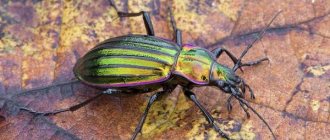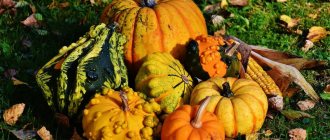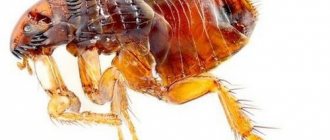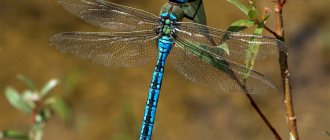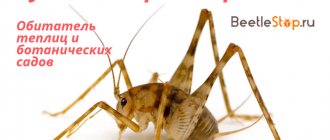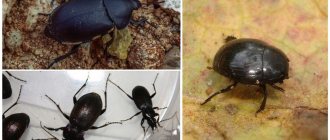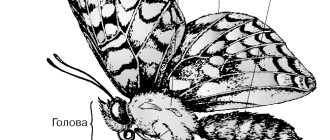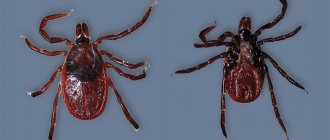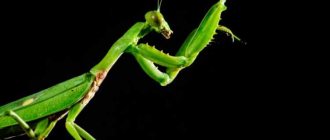During evolution, some insects changed the structure of the front pair of wings. The result was hard elytra filled with chitin. Because of this, the new order received the name “Coleoptera”, and popularly simply “beetles”. In terms of quantity and diversity, this is the largest group of living beings on the planet. Let's look at all the variety of species and in our review the most beautiful species of beetles living in nature.
Photos of the most beautiful species of beetles:
1
Ground beetles
Ground beetles (Carabidae) are mostly voracious predators. Strong legs and powerful jaws allow them to hunt successfully, destroying caterpillars, slugs and beetles. They live everywhere. The fauna of Russia and neighboring countries includes approximately 3,000 species.
A significant portion of ground beetles are black, but there are also colorful, bright exceptions
Rhinoceros beetle / Oryctes nasicornis
There is an elephant, and there is also a rhinoceros beetle. It lives in the deciduous forests of Europe, but over time it has developed a taste for other natural landscapes.
It grows up to 4 cm in length, and can be recognized by the characteristic horn on its head. It resembles a rhinoceros horn, hence the species name. They crawl out of shelters at night, and during the day they prefer to hide in the foliage, under the bark of trees.
On the island of Crete, during archaeological excavations, terracotta figurines in the idea of rhinoceros beetles were found. Such figurines date back to 2000–1600 BC.
8
Water bugs
The aquatic, predominantly carnivorous beetles include diving beetles (Dytiscidae), whirligigs (Gyrinidae), and water-loving beetles (Hydrophilidae). The first two families are active predators not only at the adult stage, but also at the larval stage; water lovers are omnivores, but mainly feed on plant foods.
The large black water lover (lat. Hydrophilus piceus) reaches 48 mm in length
Golden Bronzewort / Cetonia aurata
These are quite large beetles, growing up to 2.3 cm in length. There are 7 subspecies found in nature, which differ in body structure and color.
The bronze vulture has spread throughout Eurasia. You won't find them only in deserts and mountainous areas. It feeds on flowers of fruit trees, wild and cultivated plants. But it is not capable of causing significant damage to garden plants and agricultural crops.
Subspecies come in a variety of colors, from bronze to metallic grey. It was first described by Carl Linnaeus in 1758. We also call them cockchafers.
3
Dead eaters
The orderlies of our fields and forests are carrion eaters (Silphidae). A large number of these beetles accumulate near the corpses of dead animals, dig under the corpse, scooping out the soil from under it. Thus, they lower the corpse into the ground, where they then eat it together with their larvae. One of the few beetles that care for their offspring: adults feed the larvae, although they are capable of feeding on their own.
Gravedigger, or black-whiskered gravedigger (lat. Nicrophorus vespilloides)
Brazilian bigtooth woodcutter / Macrodontia cervicornis
One of the largest beetles in the world. Because of its large horns, it received a Latin name, which is translated into Russian as “large-toothed staghorn.”
Biologists recorded a maximum size of 178 mm. The stag-horned representative of the Coleoptera settled in the southern part of the South American continent. They feed on leaves and flower pollen. They easily split the bark of trees with their horns.
A very rare species. It is under guard. He has many natural enemies. Birds happily eat larvae, as well as adults.
13
Lamellaridae
Lamellar beetles (Scarabaeidae), like many other beetles, are diversely represented in the tropics. 435 species of scarabaeids have been identified in the fauna of Russia. The largest tropical species is the African goliath, which was previously considered the largest among beetles. But later, a giant creaking creature larger than a goliath was discovered in the tropical forests of America.
Tropical bronze
general characteristics
Name: Beetles or Coleoptera Lat.: Coleoptera
Class: Insects - Insecta
| Habitats: | everywhere except cold regions |
| Dangerous for: | depending on the type |
| Means of destruction: | folk, chemical, prevention |
Beetles are a group of insects with complete metamorphosis. Almost 3 tons of fossil species have been studied, but a large number are unstudied. They are distributed everywhere, in addition to Antarctica, the Arctic and the highest mountains. But the most attractive specimens can be admired in the tropics.
Stag beetle
The stag beetle, a member of the stag beetle family (Lucanidae), is the giant of our forests; its length together with horns is 6-8 cm. This species is common in deciduous and mixed forests. Almost everywhere, the population of this species is low and continues to decline, so it is listed in the Red Books of both Russia and the countries where it lives. Male stag beetles have strong mandibles, similar to deer antlers, with which they fight. The larvae of these six-legged deer live in rotten stumps and hollows for five years before becoming beetles.
Duel between male stag beetles
Alpine longhorned beetle / Rosalia alpina
There is such an original beetle in the world that has spread throughout Europe. Forest beetles in the mountains rise to a height of 1,500 meters above sea level, which is why they received their species name.
Adults grow up to 3.5 cm in length. The body, head, limbs and antennae are covered with an original pattern. You won’t find specimens with the same color.
The barbel is the only representative of the relict genus Rosalia, which lives in the vast expanses of Europe. The number of the species is declining. The main cause of extinction is deforestation.
6
Zlatki
Gold beetles (Buprestidae) are very beautiful. Golden, green, yellow, with multi-colored spots. All borers have a very durable shell. They feed on leaves or thin bark of plants, causing significant damage to plants. In sunny weather, beetles quickly run from one place to another along tree trunks heated by the sun; No wonder they are called “children of the sun.”
Chrysanthemum on a buttercup flower
Marbled beetle / Polyphylla fullo
A large representative of coleopteran insects of the Khrushchia subfamily. Adults grow up to 4 cm.
It is easy to recognize by its characteristic marble pattern. There are white spots of different shapes on the dark body. Because of this original coloring they received their specific name. At the front of the head are two large antennae.
A large beetle has spread throughout southern Europe. It feeds on leaves, flowers of fruit and agricultural plants. The larva happily eats plant roots.
Narynniki
Blister beetles (Meloidae) have bright, often spotted warning colors. The blood of these beetles contains cantharidin, a substance that causes deep ulcers on the skin.
Epicauta hirticornis
T-shirt scarred
Why are beetles singled out among insects?
Looking at the photos of beetles existing on Earth, one can ask the question what unites them, so dissimilar in size, color and appearance. Like other insects, the body consists of a head, chest and abdomen; there are sensory organs, often reduced as unnecessary, due to the way of life. For example, compound eyes are not needed in forms that live in caves or underground, and in other cases they are placed on the crown, behind, or look up and down at the same time.
The wings of other insects are designed for flight and are reinforced with veins. In the beetle, the front ones became chitinous elytra, covering the wings for flight. However, in some beetles they are absent, while in others they are fused and do not open, and wing venation is also present. Some have a large male, who sometimes enters into battle for a female or a place to lay eggs, while others, on the contrary, have a large female and a small father of the family, whose main task is only fertilization.
The care of some species of beetles for their own offspring looks very touching in the photo. They can care not only for future larvae, storing food for them, but also for larvae and already laid eggs. One leaf beetle even makes a capsule for eggs from its own feces, and another not only makes a notch in the wood before laying, but also closes it with a lid, for the manufacture of which the female secretes a special secretion.
Different types of beetles can run, and very quickly, some of them jump, jump, many fly, both slowly and at considerable speed. They talk to each other using sounds and, in some cases, humans hear them too. The ability to glow is simply amazing and is an incredibly beautiful sight in photos and in life. Upon careful examination, it is revealed that everything in their design is expedient, and even if it sounds loud, but sometimes it seems that they are the real masters of the planet.
ladybugs
We often encounter small predators - ladybugs (Coccinellidae). These are beneficial insects and are often used in biological control of plant pests.
Ladybugs eat aphids and scale insects
Seven-spotted ladybug
Habitat
Beetles are found all over the world, they live in forests, steppes, deserts, and tundra. Insects rarely live where there is permanent snow; they are not found in Antarctica. Beetles are found:
- in black soils;
- in the bark of trees;
- in deciduous cover.
Some species inhabit deserts. Such insects are adapted to different environmental conditions. They forage for food at night.
Most representatives of the Coleoptera order prefer to drink fresh and slightly salted water.
Leaf beetles
Among the brightly colored and often poisonous leaf beetles (Chrysomelidae), the Colorado potato beetle, which was brought from North America 100 years ago, is widely known. In its homeland, the striped beetle feeds on wild plants of the nightshade family, and in new conditions it has become a serious pest of potatoes.
The leaf beetle (lat. Chrysolina fastuosa) can feed not only on the leaf beetle, but also on nettles, mint and many other plants
Mating season
Male representatives of the insect class fight with each other, occupying the most comfortable places. Males actively forage for food and often fight for females. Beetles are higher insects; their reproduction requires complete transformation. The egg passes into the larval stage, which becomes a pupa and subsequently develops into a full-fledged individual.
The female hides the eggs in fallen leaves or places them in stones. The larva can hatch in the bark of a tree, in curled leaves.
The eggs are usually white, green or yellow. On their surface there is a thin leathery shell. The size of the egg depends on the type of beetle in question. On average, it lives 15-20 days, after which it turns into a larva.
Larvae can be seen in the soil and tree bark. They are:
- yellow;
- white;
- pinkish.
The outer integument is brown or green and may have brown spots on the surface. The larvae differ not only in shape, but also in body structure; they are often elongated and dense. Some of them look like worms.
Some larvae have a chitinous layer, others do not. The head has hard coverings and a developed oral apparatus. When the larva develops, it molts. Life expectancy depends on the type of female and male, and the climatic features of the area play an important role. The larva can live from 2 months to 5 years. It should be noted that some arthropods reproduce in the larval stage.
Coleoptera representatives of the “Insect” class contribute to the pollination of garden crops. Beetles eat animal remains, resulting in faster decomposition processes. Predatory species are beneficial for the crop because they destroy their harmful counterparts. The importance of beetles in nature and human economic activity is difficult to overestimate. “Forest nurses” improve the ecosystem.
Weevils
Bristle nodule weevil
Rice weevil
Barn weevil
Imago lifestyle
Clumsy insects with a thick body stay on the ground and crawl along stumps and herbaceous plants. Adults feed on cereals and love clover, dandelions, buttercups, anemones, and violets. If they find themselves near fields with vegetables, they damage agricultural crops. Beetles can be found in various biotypes: steppes, meadows, forest edges. To continue the life cycle, it is important to have nearby open areas suitable for solitary bees to settle.
Information. On a hot day, the beetles hide under the leaves; their soft abdomen is buried in the ground to avoid drying out.
Adults appear in spring, in April. After additional feeding they begin to mate. Beetles are slow and clumsy and do not run away from danger. Their hemolymph contains a highly toxic substance called cantharidin, which can kill small animals. When the oily liquid comes into contact with human skin, it causes an allergic reaction and blisters appear.
Interesting fact. In case of danger, the purple T-shirt falls to the ground and pretends to be dead. An additional defense mechanism is an oily, unpleasant-smelling liquid secreted from the joints of the limbs and abdomen.
In regions where the area of meadows is shrinking, construction is taking place, plowing is taking place, grass is being mowed, and the number of purple t-shirts is decreasing. Due to the lack of wings, beetles cannot move long distances in search of new habitats.
Reproduction
Mating is the finale of the life of males; after transferring the seed to the female, they die. For laying, a place is chosen close to a colony of solitary bees. The female digs a hole in soft soil. In one clutch the number of eggs reaches 1000 pieces. The female makes 2-3 separate burrows with eggs. After this, it also dies. The larvae appear after 30-40 days.
The blister family is characterized by hypermetamorphosis. This type of insect development is transitional between complete and incomplete metamorphosis. The first instar larvae, called triungulins, differ from the older instars. External differences are related to lifestyle. Triungulins are actively moving, looking for hosts for further development. Once in a bee's nest, they moult and turn into short-legged, worm-like parasites that feed on honey. Before true pupation, insects go through a “false pupae” stage.
Bark beetles
Previously, bark beetles were considered a separate subfamily, but now they are classified as weevils. Small beetles, pests of tree species. Adult beetles can make “ticking” sounds by tapping their heads against the walls of tunnels they have gnawed into wood - they can often be heard in old wooden houses at night. A number of species have a device for removing debris that interferes with movement along the passages - a depression in the elytra, which is called... a wheelbarrow! Yes, yes, friends, these are the only bugs with cars.
Great spruce beetle (lat. Dendroctonus micans)
Twirly
This family of small-sized water beetles (on average about 6 mm) includes several hundred species, mostly inhabiting tropical waters, but such beetles are also found in the northern regions, in particular in fresh water bodies near the Black Sea coast, in Sweden, Norway, Spain. And a couple of dozen species live in Russia.
Such beetles, like the previous ones, belong to the suborder of carnivores and feed on small aquatic life, not only alive, but also dead. Their way of digesting food is very interesting, because the main processes occur not inside, but outside their body. The spinners inject enzymes into their prey, which dissolves it, and then only suck it up.
The body shape of such creatures is oval, convex; The color is predominantly black and shiny. On the surface of the water they move energetically, quickly, stay in groups, constantly describing circles and dancing in circles without rest, for which the beetles got their name. And only sensing a threat, they dive into the water.
In addition, they can fly, as they are naturally endowed with membranous, well-developed wings. For their tirelessness, these waterfowl insects have been awarded the title of the fastest swimmers among their own kind. The largest species of such organisms are found in East Asia; their representatives can grow to a size of two or more centimeters.
Nutcrackers
Click beetles have short legs, and if they fall on their backs, it is difficult for them to roll over. To regain support under their feet, they use an original device - something like a lever, protrusions on the chest (they can be seen in the photo below), with which they cling to the abdomen, and, straightening out, jump into the air with a click. The larvae are called wireworms, and many of them cause damage in vegetable gardens by gnawing tunnels in root crops such as potatoes. Some species, such as the blood-red click beetle (so named because of the color of the wing covers), develop in rotten wood and do no harm.
Ocellated click beetle (lat. Alaus oculatus)
Fireflies
Representatives of this large family are nocturnal beetles. They have an interesting feature because they glow in the dark. And the reason for everything is oxidative reactions in organs located at the bottom of the abdomen of insects and called lanterns, sometimes they are distributed throughout the body.
Internal light reflectors are also involved in the glow. Moreover, this process is controlled by brain nerve impulses. Fireflies are able not only to “turn on” and “turn off”, but also to regulate the brightness of their “light bulbs” at will.
In this way, they mark territory, scare away enemies, call for sexual partners, and communicate their desires and intentions to their relatives. Light signals can be green, red, blue. And their frequency largely depends on individual and species characteristics, as well as environmental parameters.
Otherwise, fireflies are similar in structure to other beetles. They have an oblong, flat, hairy, brown, brown or black body; upper protective and lower delicate wings that enable flight; comb-like antennae composed of segments; large eyes; gnawing type oral formations, atrophied in adult individuals, since they do not feed on anything, unlike the larvae.
But there are exceptions, because the females of some species resemble dark brown worms in appearance, wingless and with six legs. In conclusion, we note that the presented species of beetles ( in the photo you can see what they look like) are only a small part of those existing in nature.
After all, Coleoptera are so widespread and numerous on the planet that even scientists themselves have no idea about the number of their species in nature. One can only assume that not all of them have been discovered and many of them have not yet been described.
Features of larval development
The first instar larvae, after emerging from the earthen burrow, climb onto flowering plants, where they wait for bees. They cling to hymenoptera insects, which carry the larvae to their own nest. Once in a bee's home, the first thing they do is eat the egg. The larvae grow and develop at the expense of food reserves prepared in the nest. The victims of parasites are solitary bees of common genera: Osmia, Anthophora, Nomia. They build nests and lay eggs in the ground. Violet T-shirts live nearby, the development of which is impossible without their owners.
The body of triungulina is flat, yellow, size 1.7-2 mm. The head has pointed sickle-shaped jaws and eyes. The abdomen ends in two long setae. The legs are long, the paws have sharp claws that allow them to stay on the bee's body. After molting, the legs shorten and the eyes disappear. The larva eats honey reserves, grows and molts several times. Some parasites pupate in the bee's nest, but most leave it and burrow into the ground to a depth of 10 cm.
By autumn, the larva turns into a “false pupa”, characterized by a durable chitinous cover. In this state, she does not feed and enters winter diapause. A dense cocoon protects against drying out, climatic influences and mechanical damage. In the spring, a larva emerges from it and turns into a pupa. After a few days, the imago emerges from it.
